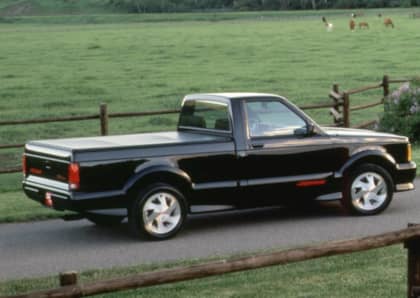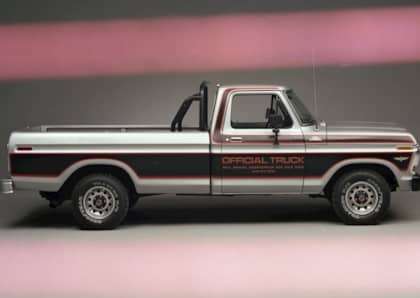8 Special Edition Classic Pickups And Trucks That Were Too Cool To Last
Starting in the 1970s and stretching well into the 1980s, truck companies did their best to make pickups and SUVs that had been on sale for over a decade somehow seem fresh and exciting. While body styles and engine details might not have changed all that much from year-to-year (Chevy and GMC ran the same pickup platform from '73-'87, while Ford offered the seventh-generation F-150 from 1980 to 1996), there was plenty of room for enterprising marketing execs to dream up 'special editions' of these otherwise frozen-in-amber autos.
Weird, wonderful, and these as days rare as many of their more highly-touted muscle car ancestors, these models walked a different path from the factory to the dealership. It's truly amazing how creative designers can get with nothing more than a set of stick-on stripes, ultra-bright colors, and an open thesaurus.
Check out these 8 special edition classic pickups and trucks that were too cool to last.
Dodge Jean Machine
Want further proof that '70s-era automakers could make a special edition vehicle out of almost any concept? Look no further than the Dodge 'Jean Machine,' a pickup that celebrated the existence of…denim.

Photo credit Bob Dombrowski
We can kind of get where Dodge was coming from here, as blue jeans and blue collars were a traditional stereotype for that time period's truck buyers. Mopar stylists chose to celebrate the Canadian tuxedo not just with nice denim upholstery on the seats, but by also including a full-wrap set of orange 'stitch' decals that make the blue-hued D100 look like it just came out of a sewing machine.

Photo credit Bob Dombrowski
It was reflective of the shout-it-out trends of the time that valued the street presence of bright orange contrasted against a gentle blue.

Photo credit Bob Dombrowski
Combined with the 'Jean Machine' sticker on the sides and tailgate, you've got an eye-catching candidate for one of the most unusual textile tie-ins in automotive history. As we'll see, however, Dodge wasn't alone when it came to dreaming of jeanery.
Ford Bronco Free Wheeling / Ford F-150 Free Wheeling
A lot about the '70's was loud, especially fashion. Sensing the chance to turn its full-size truck and SUV line-up into a rolling billboard for the most extroverted style trends of the day, Ford came out with an entire line-up of brightly-colored, deeply-stickered vehicles under the 'Free Wheeling' banner.

In some ways it was a simple formula: black out the grille, interior trim, and bumpers, and then turn up everything else. While it was possible to order silver and black Free Wheeling trucks, the most interesting models came in yellow and orange, and then doubled-down on those colors with what can only be described as 'sunset' billboard stickers or wild orange and yellow diagonal stripes. Want bright white or yellow wheels? You could get those too.

The theme continued in the cabin, with orange trim highlighting grey and black seats. The package was offered from the middle of the decade all the way to the end of 1981, which allowed them to span several generations of Bronco and F-150, as well as the Econoline van.
Jeep CJ / Jeep Cherokee Levi's Package
Wait a minute—another denim truck out of the 1970s? AMC was right up there with Dodge when it came to celebrating the light blue fabric of our lives, only this time it had a better licensing deal with the name most inextricably associated with it: Levi Strauss.

In addition to a series of Levi-specific passenger cars (including the Pacer), AMC also tapped the CJ and the Cherokee for 'Levi's Package' treatment. This entailed a more detailed interior compared to the Dodge Jean Machine (with even the headliner and sun visors denimized to match the stitched seats, which weren't actual denim but rather vinyl). There was badging, of course, along with a blue or tan top on the CJ.

Somehow, this package stayed on the books all the way from 1975 to 1986, proving just how popular seemingly dissimilar brands can be when tied together by opportunistic marketing.
GMC Beau James
The year is 1975, and GMC has decided it's time for everyone to get in touch with the softer side of pickup trucks. To this end, it creates the Beau James, a gussied up version of the Sierra representing a very early attempt to build a luxury-focused pickup truck.

The Beau James touted its 'husky' rear leaf springs and independent front suspension, tuned softer than stock to help transport a more refined truck buyer. Two-wheel drive only, the model came with a two-piece tonneau cover, 'Prado' velour seats, and a blue-and-silver color scheme inside and out.

You could choose between a 350 cubic inch engine and a 454 cubic inch unit, and of course white walls and wire wheels were also standard. Just 4,000 Beau James trucks were built by GMC, and it was only offered for a single model year.
Dodge Macho Power Wagon
Dodge's marketing efforts in the 1970s were fairly innovative, and you can draw a straight line from the Scat Pack muscle machines from the early part of the decade to the Dodge Macho Power Wagon that debuted in 1977. These were four-wheel drive versions of the brand's pickups (hence the Power Wagon appellation) that had been given the full 'Adult Toys' treatment by the company.

While the term 'Adult Toys' might tread a little too heavily on '70s swinger culture, the trucks themselves were worth a look. Black, yellow, and red were the primary colors with which Dodge painted its Macho world, and in addition to MACHO decals the trucks also came with bucket seats, a roll bar, and of course a bunch of stripes and giant 4X4 stickers stuck on the tailgate (especially if purchased in Ramcharger or Plymouth Trail Duster form).
Jeep J-10 Honcho
'Macho' and 'Honcho' might sound like they have the same linguistic root, but while the former hails from Spanish (and was popularized in Southwestern culture), 'honcho' was actually picked up by GIs after their experience in the Pacific theatre during World War II. Stemming from a Japanese word that refers to 'boss' or 'leader,' it gradually worked its way through the armed forces and become a common term throughout the late-'40s and early 1950s.

That didn't stop Jeep from combining the two terms to advertise the newest flavor of its rugged pickup truck. By the time Jeep added it as a trim level on its J-10 full-size pickup, 'Honcho' was a way for the company to indicate that this particular truck was its top dog. The Honcho got wide-track axles, additional ground clearance, and of course massive billboard stickers proclaiming its name and in some cases giving it a faux two-tone look.

Flared-fender Honchos could also be equipped with full off-road protections (cow-catcher, roll bar), and you could even get a Levi's interior with the pickup. The trucks lasted until the early part of the '80s.
GMC Amarillo GT
General Motors just couldn't pump out enough special edition Sierra pickups in-house, so it decided to tag in American Coach Corporation to pick up the slack. The end result was a trio of unusual performance trucks that paired sport and luxury

If all you wanted was a look, the entry-level Amarillo gave you a yellow paint job, and big orange sunset stripes on the rocker panels and hood. The GT went wild with turbine wheels and side pipes (as well as what passed for aero upgrades at a time when all trucks were designed using a T-square), and a tonneau cover, but it was worth saving up for the Amarillo Cowboy Cadillac. The latter added an 8-track, upgraded fabric throughout the interior, and something called a 'Trucker's Lounge' seat.

The Amarillo GT and its kin are easily spotted today by their big call-out stickers and unusual duckbill roof spoiler. At the time, they were an underrated threat when it came to straight line speed (thanks to a standard 454-cubic inch engine) and handling (due to fatter tires wrapped around those look-at-me rims).
Chevrolet Sno Chaser
Think of the Sno Chaser as the Amarillo GT for the winter crowd. Built in 1984, the Sno Chaser was based on a short box version of the Chevrolet K1500, and was available exclusively with four-wheel drive.

Photo credit GT Auto Gallery of Grand Rapids.
The Sno Chaser was part of a targeted marketing program aimed exclusively at rust belt and mountain regions where the white stuff regularly caused chaos during the winter season. That black paint along the bottom was intended to disguise the rocker guard in an effort to fight off the inevitable road salt corrosion for a few extra years. The most prominent aspect of the Sno Chaser is its 'flying bridge' spoiler that sweeps up over the cab like a cobra's cowl. Just behind you'll find a set of flat bed rails that also swell towards the front of the box like an imitation roll bar.

Photo credit GT Auto Gallery of Grand Rapids.
It's unclear, exactly, what the Sno Chaser's styling attributes had to do with winter weather, but so few of these were ever built, close to 2,500 in total, that it's unlikely you'll be able to find an owner and ask.
More From Driving Line
- Want to get away from it all? Check out these 4 classic truck campers that you didn’t know existed.











